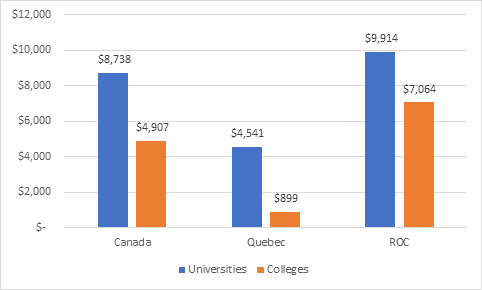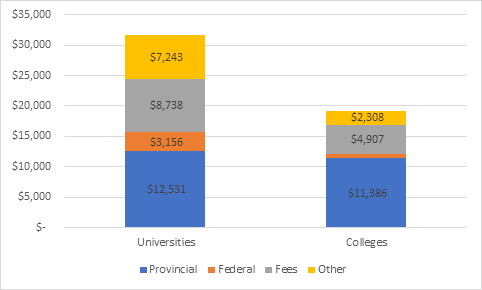[the_ad id=”11745″]
While I was putting together The State of Post-Secondary Education, 2018 I did a simple comparison looking at provincial government funding for universities and colleges, using data from FIUC and FINCOL (the Statscan surveys of the finances of universities and colleges, respectively) Here’s what I found:
Figure 1: Provincial Government Funding per Full-time Equivalent Student, 2015-16

I had a hard time believing this relatively small gap was actually true: everybody knows universities get more money from governments than colleges, right? But I checked and re-checked it over and over again: same result. Universities get $13.7 billion to spread over roughly 1.1 million FTE students while colleges get $6.6 billion for 583,000 FTE students. So, in fact, the per-student funding gap from provinces was only about 10%.
But, wait a minute, you say: total funding per student is way higher in universities than in colleges, right? What’s the deal? Well, a few things. The first is that provinces aren’t the only governments funding universities; the federal government does as well, and it puts about five times as many dollars per FTE student into universities as it does into colleges. This is about what you’d expect since 99% of federal research dollars go to universities (federal dollars to colleges are mostly for infrastructure).
Figure 2: Federal Government Funding per FTE Student, 2015-16

Another difference is tuition fees, which are higher in universities than in colleges, both because average domestic fees are higher and because universities have higher proportions of students paying international student fees (this is offset a bit – though only somewhat – by colleges having larger numbers of students paying fees in non-credential courses). This comparison is a little tricky because colleges outside Quebec have fee revenues per student which are about seven times higher than they are in la belle province, so it’s worth breaking out the numbers a bit, which I do below in figure 3. Nationally, total fee revenue per student is a little over $3,800 more in the universities than in colleges; however, the per-student gap outside Quebec is just $2,850.
Figure 3: Tuition Fee Revenue per FTE Student, 2015-2016

ROC=Rest of Canada
Now we come to the last source of income: own-source, self-generated revenue. This can include all kinds of things: private research contracts, room rentals, basketball ticket sales, residence fees, donations, income from endowments, etc. We tend not to think about this source that much, but in terms of size it is quite significant. Figure 4 shows what that income looked like on a per-student basis in 2015-16 (which, by the way, was a very bad year for self-generated income because endowment returns were practically zero – in most years the university advantage is more pronounced).
Figure 4: Self-generated Revenue per FTE Student, 2015-16

Add it all up and you see the real difference: in 2015-16, universities had income of $31,668 per FTE student, which was 65% more than what colleges received ($19,250 per student). But only 9% of this gap was due to differences in base provincial funding. The biggest difference was in self-generated income, followed by differences in fee income, followed by differences in federal funding.
Figure 5: Total Revenue per FTE student by Source, 2015-16

So, is there a funding gap between colleges and universities? Yes. It’s just not one that has anything much to do with provincial subsidies.

 Tweet this post
Tweet this post

Great analysis, Alex. Beyond the sectoral differences in average tuition rates and international student enrolment, colleges and polytechnics also get hurt by not having the same opportunities as universities to exploit the long tail of the tuition distribution with high-yield “cash cow” programs. I don’t have the disaggregated TLAC tables in front of me, and of course, there’s no college/polytechnic equivalent for comparison, but I would imagine that tuition fees for the most expensive niche continuing ed programs at colleges and polytechnics don’t rival those of professional masters programs.